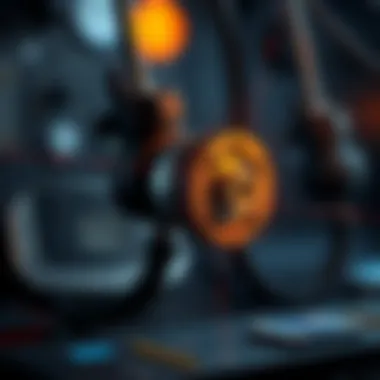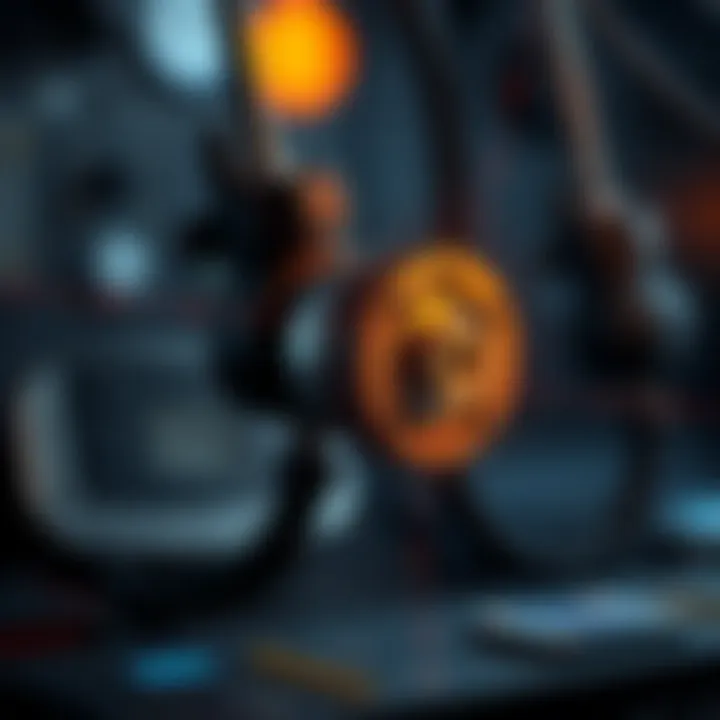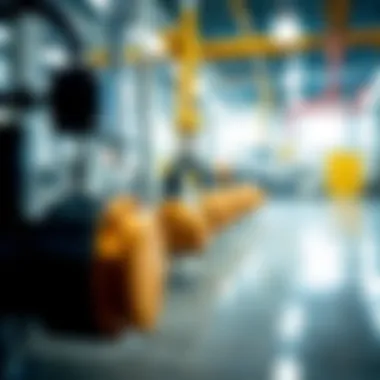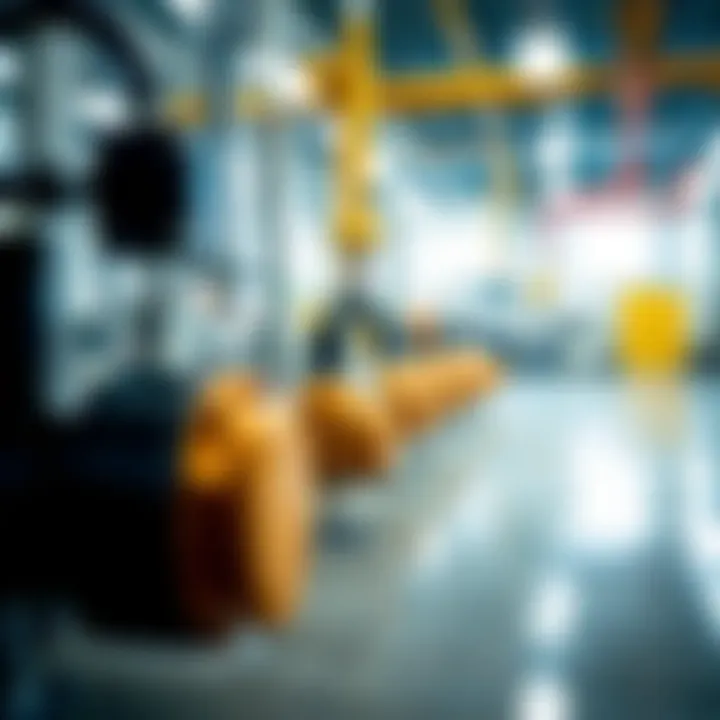Exploring the Landscape of Pressure Sensing Devices


Intro
The realm of pressure sensing devices is not just a niche in the broader spectrum of technology; it plays a pivotal role across diverse industries. From aerospace to healthcare, pressure sensors are at the heart of systems that depend on precise measurements. These devices enable engineers and technicians to monitor, maintain, and advance systems by providing key data on pressure changes.
Understanding how pressure sensing devices function and their myriad applications is essential for students, researchers, and professionals alike. A comprehensive grasp of these instruments prepares one to leverage their capabilities, enhancing safety and efficiency in their respective fields. This exploration into pressure sensing devices is akin to navigating a complex but fascinating maze, where each turn reveals something novel and impactful.
Prelims to Pressure Sensing Devices
Pressure sensing devices play a pivotal role in various fields such as engineering, healthcare, aviation, and automotive industries. Their ability to measure and regulate pressure has become fundamental to safety and efficiency across these sectors. By optimizing processes and enhancing accuracy, these devices not only bolster productivity but also conserve resources, making them indispensable in modern technology.
In this article, we will delve into multiple facets of pressure sensing devices, including their definitions, historical development, and the mechanisms behind their functionality. We will also explore the different types of sensors currently in use and their practical applications across diverse industries. Understanding these devices leads to better selection, optimization in performance, and ultimately contributes to industry-wide advancements.
Defining Pressure Sensing Devices
At its core, a pressure sensing device is a tool designed to gauge the force exerted by a fluid (liquid or gas) against a surface. This force, or pressure, is most commonly measured using a variety of sensor technologies. These devices can convert the mechanical force of pressure into an electrical signal that is easier to interpret and utilize.
Pressure sensors can be found in a plethora of computing apparatus, vehicles, and industrial equipment. They provide crucial data that helps in monitoring conditions—be it hydraulic systems, HVAC machinery, or even rural applications such as monitoring irrigation systems. Each application demands very specific characteristics, like sensitivity and environmental resilience, which play a huge role in how these devices are designed and implemented.
History and Evolution
The journey of pressure sensing devices dates back centuries. The first rudimentary designs were likely nothing more than simple water columns or Bourdon tubes observable in mechanical gauges. Over time, innovations led to more complex systems. The development of the Bourdon tube, invented in the mid-19th century, revolutionized the field. It enabled more precise readings through a coiled tube that deformed under pressure—offering a practical approach to pressure measurement, even in harsh environments.
As technology advanced, the advent of electronic sensors marked a significant turning point. In the latter part of the 20th century, strain gauges and capacitive sensors emerged, allowing for real-time data processing. This evolution paved the way for the integration of sensors in areas previously thought impractical, such as wearable devices in healthcare. Now, with the rise of IoT, pressure sensing devices can collect data and transmit it wirelessly, creating opportunities for remote monitoring and enhanced user experiences.
All these developments highlight not only the technical ingenuity required to adapt to various pressures and environments but also the ongoing commitment towards improving our ability to measure and manage pressure effectively in virtually every aspect of modern life.
Fundamental Principles of Pressure Measurement
Pressure measurement forms the bedrock of understanding and navigating various physical phenomena. It isn't merely about numbers; it’s about interpreting those numbers to make crucial decisions in countless fields, such as engineering, healthcare, and environmental monitoring. Grasping the fundamental principles of pressure measurement lets us decode how systems behave under different conditions, thus allowing for enhanced design and operational efficiency. This section will illuminate the groundwork of pressure measurement, focusing on essential elements, benefits, and considerations that provide insight into both everyday applications and complex industrial processes.
Basic Physics of Pressure
To grasp pressure measurement, we must first return to its essence—the basic physics of pressure itself. Pressure is defined mathematically as force per unit area. In simpler terms, it refers to how much force is applied to a surface over a specific area. This concept is crucial in multiple disciplines.
There are diverse contexts in which pressure surfaces, from weather forecasting to machining metal. The two most common units of pressure are Pascals (Pa) and pounds per square inch (psi). These units help to standardize measurements so professionals can compare notes and data without a hitch.
- Pressure in Fluid Dynamics: When fluids flow through pipes, pressure acts as a guiding force, driving the movement of liquids and gases. Understanding how pressure interacts with flow allows engineers to design efficient systems.
- Environmental Monitoring: Atmospheric pressure, for example, informs meteorologists about changing weather patterns. This understanding helps predict phenomena ranging from rain to drought.
In practice, pressure can be felt—like the squeezing of a balloon or the weight of water in a deep pool. Devices that measure pressure, therefore, operate on these physical principles and convert that intangible essence into quantifiable data that can aid decision-making across sectors.
Types of Pressure: Absolute vs. Gauge
Differentiating between absolute and gauge pressure is vital for anyone dealing with measurements. Both serve distinct purposes and convey varied information, making it essential to understand each.
- Absolute Pressure: This measurement considers the total atmospheric pressure, meaning it is the pressure relative to a perfect vacuum. This type of pressure is crucial in scientific applications, where accurate baselines are needed.For example, when working with gas laws in chemistry, absolute pressure enables accurate calculations for gas behavior under varying conditions.
- Gauge Pressure: In contrast, gauge pressure measures pressure relative to atmospheric pressure. This means that a gauge pressure reading of zero indicates that the pressure equals the surrounding atmospheric pressure. It is commonly used in practical applications, such as tire pressure, where knowing how much pressure exceeds atmospheric levels is more useful than the total pressure itself.
Knowing the difference between absolute pressure and gauge pressure can prevent costly mistakes in industrial settings, where precise readings can mean the difference between optimum performance and failure.
Understanding these concepts not only enhances measurement accuracy but also aligns expectations with the realities of physical systems. When specialists select the appropriate type of pressure to measure, they are not just getting numbers, but are acquitting themselves with a deeper understanding of systems in play.
In summary, the fundamental principles of pressure measurement serve as the cornerstone for developing advanced technologies and methods that touch every aspect of modern life. Knowing these principles is essential, providing the necessary insights to innovate and improve across multiple disciplines.
Types of Pressure Sensors
Pressure sensors are essential components across many industries, and understanding the types available can help in selecting the right device for a specific application. Each type of sensor operates on differing principles, offering unique benefits and drawbacks depending on the context of use. Mechanical sensors are often used for their robust nature, while electronic sensors provide high precision. Moreover, optical and digital sensors introduce distinct features that cater to sophisticated needs.
Mechanical Sensors
Mechanical sensors are the traditional workhorses in pressure measurement. They leverage physical changes, such as deformation, to gauge pressure levels. Often found in industrial applications, they’re recognized for their reliability and simplicity.
Bourdon Tubes
Bourdon tubes are a classic choice in the realm of mechanical pressure sensors. Their fundamental design involves a curved metal tube that straightens slightly under pressure, which then rotates a needle on a dial to show the pressure reading. One of the standout characteristics of Bourdon tubes is their durability, making them suitable for high-pressure environments. They’re a popular pick in industries like oil and gas, where resilience is paramount.
- Advantages:
- Disadvantages:
- Durability: Can withstand harsh conditions and high-pressure levels.
- Simplicity of Use: Easy to read and interpret results.


- Limited Accuracy: Not as precise as some electronic alternatives.
- Size Constraints: Their size can be a limitation in more compact installations.
Diaphragm Sensors
Diaphragm sensors utilize a flexible membrane that bends under pressure to provide readings. This design allows for high sensitivity and can measure very small pressure changes, making them invaluable in applications that require precision measurement.
- Key Characteristic: High sensitivity, which allows for detailed readings, especially in low-pressure scenarios.
- Advantages:
- Disadvantages:
- Versatility: Can measure both gases and liquids.
- Compact Size: Often smaller than other mechanical sensors.
- Calibration Needs: May require frequent adjustments to maintain accuracy.
- Material Limitations: Certain materials may not withstand specific fluids or environments.
Electronic Sensors
As technology advances, electronic sensors have gained traction due to their precision and versatility. They often rely on electrical properties to measure pressure, making them ideal for applications where detailed analysis and data collection are critical.
Strain Gauge Sensors
Strain gauge sensors work by measuring the deformation of a small wire or foil as pressure is applied. The change in resistance due to deformation is directly related to the pressure exerted. This aspect makes them useful in high-accuracy applications.
- Key Characteristic: They've become famous for their ability to measure minute pressure changes accurately.
- Advantages:
- Disadvantages:
- High Accuracy: Excellent for applications requiring precision, such as laboratory settings.
- Integration: Easily integrates with digital systems for data analysis.
- Temperature Sensitivity: Performance can be affected by external temperature changes.
- Installation Complexity: Proper installation and calibration can be a challenge for some users.
Capacitive Sensors
Capacitive sensors measure pressure by detecting changes in capacitance between two conductive plates separated by a dielectric material. They excel in applications requiring a compact design and can be used in both static and dynamic pressure measurements.
- Key Characteristic: High sensitivity and fast response time make them attractive in real-time monitoring scenarios.
- Advantages:
- Disadvantages:
- Compact Design: They can be miniaturized for various applications.
- Low Power Consumption: Ideal for battery-operated devices.
- Higher Cost: Typically more expensive than mechanical options.
- Environmental Sensitivity: Requires care in use within extreme conditions.
Optical and Digital Sensors
Innovations in technology have led to the emergence of optical and digital pressure sensors. These sensors provide unique capabilities that enhance measurement accuracy and data processing.
Fiber Optic Sensors
Fiber optic sensors use light transmitted through optical fibers to measure pressure variations. The pressure causes changes in the light's path, allowing for precise readings without electromagnetic interference. This specific aspect provides an edge in delicate environments.
- Key Characteristic: They are immune to electromagnetic interference, making them perfect for sensitive environments.
- Advantages:
- Disadvantages:
- High Sensitivity: Can detect minute pressure changes.
- Versatility: Operable in various environments, from harsh industrial settings to delicate applications.
- Complex Installation: Requires specialized knowledge for setup.
- Costly: The advanced technology comes with a higher price tag.
MEMS-based Sensors
MEMS (Micro-Electro-Mechanical Systems) sensors are miniaturized devices that combine mechanical and electronic components on a single chip. These sensors are noted for their compact size and ability to function in a wide variety of environments.
- Key Characteristic: Reliability and scalability attract a broad range of applications from automotive to healthcare.
- Advantages:
- Disadvantages:
- Miniaturization: Ideal for applications with space constraints.
- Low Power Use: Suitable for portable devices, including smartphones and wearables.
- Cost of Production: Although prices are falling, they can still be higher than traditional sensors.
- Potential Sensitivity to Environment: Economic factors like humidity or temperature may impact readings occasionally.
Understanding these various types of pressure sensors provides vital insight into selecting the right pressure sensing device for specific needs. With emerging technologies and innovations, the landscape will continue to evolve, allowing for more precise measurements across multiple industries.
Applications Across Industries
Pressure sensing devices are an integral part of modern technology, weaving their utility across a multitude of sectors. Understanding their applications is critical, as they underscore not only the functions of various systems but also the reliability and safety they bring to operations. By grasping how these devices are employed, one can appreciate the myriad benefits they offer, from enhancing the efficiency of processes to safeguarding lives and assets.
Aerospace and Defense


In the realm of aerospace and defense, precision is paramount. Pressure sensors play a crucial role in monitoring cabin pressure in aircraft, ensuring passenger comfort and safety at high altitudes. For example, in military applications, pressure sensing devices are vital for the deployment of air pressure systems in weaponry and surveillance equipment, where inaccuracies can lead to dire consequences. Moreover, these sensors help in fuel management systems, allowing for efficient monitoring of fuel levels under varying flight conditions. Their ability to withstand extreme environments further solidifies their importance in this high-stakes industry.
Healthcare and Medical Equipment
The healthcare sector relies heavily on accurate pressure measurement for patient care. From blood pressure monitors to ventilators, pressure sensing devices are embedded in a multitude of medical instruments. These devices ensure that critical parameters are maintained within safe limits. For instance, respiratory devices utilize pressure sensors to regulate airflow for patients undergoing treatment, guaranteeing optimal oxygen delivery. Moreover, the integration of these sensors into wearable technology is on the rise, leading to continuous monitoring of health vitals, which allows for timely interventions. With improved accuracy and response time, pressure sensors in healthcare are transforming patient management practices.
Automotive and Transportation
In automotive applications, pressure sensors contribute significantly to vehicle safety and efficiency. Tire pressure monitoring systems exemplify the importance of accurate pressure measurement, alerting drivers to under-inflation which can lead to accidents. Additionally, pressure sensors are employed in fuel systems, optimizing performance while ensuring stricter emissions control. In the burgeoning field of electric vehicles, these sensors are crucial for monitoring battery pressure and health. They serve an essential function in overall vehicle diagnostics, ultimately enhancing both performance and consumer safety.
Industrial Automation
Industrial automation benefits extensively from pressure sensing technology. In manufacturing processes, maintaining the correct pressure is key to quality control and energy efficiency. Sensors are commonly used in hydraulic systems, providing feedback on pressure levels to ensure optimal operation of machinery. Automated systems rely on these measurements for real-time adjustments, thereby minimizing waste and maximizing productivity. Furthermore, as industries adopt smart manufacturing practices, the integration of Internet of Things (IoT) technology allows for enhanced data collection and analysis, leading to predictive maintenance and operational excellence.
"Pressure sensing devices are not just components; they are vital in ensuring safety and efficiency across various industries."
As this demonstrates, pressure sensing devices are not mere tools but are indeed the backbone of modern operations across critical sectors, emphasizing the necessity for continual improvement and innovation in their design and application.
Selecting the Right Pressure Sensor
Choosing the right pressure sensor is a crucial step, whether you're overseeing an industrial operation, tackling a research project, or simply seeking precise measurements for a healthcare application. Selecting wisely not only optimizes performance but also enhances safety and reliability in critical systems. Here are some essential elements and benefits to consider that can help guide your decision in this complex landscape.
Key Factors to Consider
Operating Range
The operating range of a pressure sensor refers to the spectrum of pressures it can accurately measure. This is fundamental for ensuring that the sensor can perform effectively under the specific conditions it will encounter. If a sensor operates outside its designated range, readings become unreliable—like trying to read a thermometer that only works between 0°C and 100°C when you need it to measure temperatures from -50°C to 150°C.
The pivotal characteristic of the operating range is its specification in terms of minimum and maximum pressure. This characteristic makes it critical for various applications, particularly where extreme pressures exist, such as deep-sea or high-altitude environments. A pressure sensor with an effectively wide operating range often ends up being a beneficial choice for many industries because it simplifies inventory management and reduces the need for multiple devices.
However, too broad of a range can sometimes mean decreased accuracy. It’s a balancing act between versatility and precision.
Accuracy
Accuracy, undoubtedly, is king in the realm of pressure measurement. The degree to which a sensor’s output corresponds to the actual pressure is crucial, especially in fields like healthcare where precise readings can impact patient safety. When discussing accuracy, it’s common to refer to the percentage deviation from the measurement, often expressed as a fraction of the full scale.
A highly accurate pressure sensor can be the difference between success and failure in many applications. From industrial machinery needing to maintain tight tolerances to weather stations requiring precise atmospheric readings, accuracy can make or break a project. More accurate sensors tend to cost more and may require sophisticated calibration and settings, but they are essential in applications where minor deviations can lead to significant consequences.
Response Time
A pressure sensor’s response time measures how quickly it can react to changes in pressure. This is especially vital in dynamic systems where pressure can fluctuate rapidly, such as in pneumatic systems or during experiments in fluid dynamics. The response time impacts the real-time effectiveness of the systems in which the sensor is integrated.
For instance, a sensor with a rapid response time allows for immediate adaptations in automated systems, enhancing operational efficiency. Typically, this characteristic makes the sensor adapt more smoothly to abrupt changes. So when looking for precision, notice that sensors with shorter response times are typically the more attractive option, particularly in high-performance applications.
However, the downside might be that faster response times can sometimes lead to higher costs or complexity in installation and integration. Thus, one must weigh trade-offs against specific application requirements.
Environmental Considerations
Environmental factors can greatly impact the effectiveness and longevity of pressure sensors. External conditions have to be taken into account to make a well-informed selection.
Temperature Effects
Temperature plays a significant role in the operation and reliability of pressure sensors. Most sensors will have an optimal temperature range within which they perform accurately.
When temperatures slide outside of these parameters, the sensors may yield misleading data. For instance, a sensor designed for refrigeration may falter when used in a hot industrial furnace. This characteristic underscores why understanding temperature effects is essential for reliable pressure readings. Moreover, environmental effects can lead to physical degradation over time, affecting performance.
Therefore, choosing a sensor that accommodates the expected temperature variations in its working environment is a wise strategy. Not doing so is like trying to make soup in a leaky pot. You lose both flavor and effectiveness.
Atmospheric Conditions
Weather, humidity, and other atmospheric conditions can also impact sensor functionality. This element is particularly pertinent for sensors deployed in outdoor conditions or in sectors like oil exploration or meteorology, where pressures can vary significantly due to atmospheric changes.
The uniqueness of atmospheric conditions lies in their unpredictability—weather can turn on a dime, and sensors need to be resilient enough to handle those fluctuations. A pressure sensor capable of maintaining accuracy under varying atmospheric conditions provides a solid advantage, particularly for applications where integrity and reliability are non-negotiable.
Selecting the right pressure sensor requires a meticulous understanding of your specific application needs, environmental conditions, and operational parameters. As you navigate the complexities of sensor technologies, these insights can provide a sturdy foundation upon which to build your decisions.
Challenges in Pressure Sensing Technology


In the evolving realm of pressure sensing devices, overcoming challenges is as crucial as the technology itself. Not only do these hurdles affect the performance and reliability of pressure sensors, but they also dictate their application across different sectors. Understanding the challenges in pressure sensing technology helps manufacturers, developers, and end-users make informed decisions. Here we will discuss significant issues affecting the effective deployment of these devices, ultimately spotlighting the need for continual innovation and improvement.
Limitations of Current Sensors
Pressure sensors, despite being an invaluable part of modern technology, still grapple with several limitations. Here are some notable points to consider:
- Sensitivity to Environmental Conditions: Current sensors can often be thrown off by environmental factors like temperature fluctuations, humidity, and vibration. These variables can lead to incorrect readings, affecting reliability.
- Durability: Many standard sensors may not withstand extreme conditions. For example, sensors used in aerospace need to endure high pressures and temperatures which not all devices can handle effectively.
- Response Time: In rapid pressure changes, some sensors struggle with timely readings. This lag can be detrimental in fields such as healthcare and automotive, where immediacy is vital.
- Calibration Needs: Regular calibration is necessary to maintain accuracy, yet this can be a time-consuming process. It require specialized equipment and expertise, preventing quick deployment in certain situations.
The interplay of these limitations greatly influences the effectiveness of pressure sensing solutions. A sensor that performs well in a controlled environment might not deliver the same results in a dynamic, real-world application. This inconsistency is a primary concern for engineers and researchers.
Calibration and Maintenance Issues
Calibration and maintenance are critical aspects to ensure that pressure sensors operate at peak performance. If a sensor goes uncalibrated, its readings can veer off-course, potentially leading to dangerous or costly errors. Here are some insights into this intricate topic:
- Frequent Calibration: Depending on the usage and conditions, some sensors may need calibration multiple times within a short span. This can create downtime and increase operational costs.
- User Expertise: Not all operators have the necessary skills to calibrate sensors correctly. Lack of training can lead to further inaccuracies.
- Technological Integration: With the rise of smart sensors, integrating maintenance protocols such as self-calibration offers a promising solution, but isn't yet widespread. Relying on advanced systems to monitor performance can mitigate human error but requires initial investment and understanding.
- Documentation and Compliance: Keeping detailed records of maintenance and calibration is essential for compliance with industry standards. In medical and aerospace fields, failure to adhere to stringent regulations can lead to severe consequences.
"An uncalibrated sensor is like a compass pointing in the wrong direction; you might never find your way home."
In summary, addressing the challenges faced in pressure sensing technology not only promotes better products but also enhances safety and functionality across various applications. As advancements continue, some of these issues may see resolution, but the ever-evolving nature of technology implies that new challenges will likely emerge. Industry professionals must stay ahead by considering these factors when selecting and implementing pressure sensing devices.
Recent Innovations in Pressure Sensing Devices
As technology moves at breakneck speed, the world of pressure sensing devices is not left behind. Understanding the recent innovations in this field is crucial for professionals, researchers, and enthusiasts alike. While the foundational principles of pressure measurement remain constant, the advancements made in materials and smart technologies have transformed how we detect and interpret pressure.
Advancements in Materials Science
New materials are stepping in to redefine efficiency and accuracy in pressure sensors. For instance, the emergence of nanomaterials has caught the attention of scientists and engineers. These materials, often employed in nanoscale sensors, allow for incredibly sensitive readings. By leveraging their unique properties, such as high surface area and electrical conductivity, manufacturers can create sensors that activate at much lower pressure levels than their predecessors.
The use of graphene, a one-atom-thick layer of carbon, has been particularly notable. It can withstand extreme conditions while still yielding precise pressure readings. Moreover, composite materials that blend various elements are being designed to enhance durability and functionality in harsh environments. Overall, these advancements provide a robust solution for the diverse applications of pressure sensors, from aerospace to healthcare.
Integration of IoT with Pressure Sensors
The integration of the Internet of Things (IoT) with pressure sensing devices marks a pivotal shift in how we interpret pressure data. By connecting sensors to the internet, real-time monitoring becomes not just a dream but a tangible reality. This synergy allows for extensive data analytics, where devices communicate vital information to centralized systems or cloud storage.
Here are a few benefits stemming from this integration:
- Remote Monitoring: Operators can receive updates on pressure levels from anywhere, significantly improving response times in critical situations.
- Predictive Maintenance: IoT-enabled pressure sensors can flag anomalies before they escalate, allowing for proactive maintenance schedules and reducing downtime.
- Data-Driven Decisions: Access to large data sets helps organizations make informed decisions concerning efficiency and resource management.
"As pressure sensors transcend traditional boundaries, the integration with IoT is setting a new standard in monitoring and analysis, transforming data into actionable insights."
However, this evolution isn't without its challenges. Cybersecurity issues, for instance, become paramount when dealing with sensitive data transmission. Yet, with the right safeguards, the benefits of IoT integration far outweigh the potential risks.
In summary, the landscape of pressure sensing devices is more dynamic than ever due to innovations in materials science and the integration of IoT technologies. These advancements not only boost efficiency but also open avenues for smarter, data-driven environments across various industries.
Future of Pressure Sensing Technology
The landscape of pressure sensing technology is on the brink of a significant transformation. In this ongoing journey, understanding the future trends is not merely an academic exercise but a necessity for professionals and industries alike. This section will explore current trajectories, innovation, and research potential that are shaping the next wave of pressure sensing technologies. With increasing demand for precision, reliability, and real-time data, the advancement of these devices is paramount.
Emerging Trends
Several trends are coming to the forefront within the pressure sensing realm. These developments provide insights into how technology is evolving:
- Smart Sensors: The integration of the Internet of Things (IoT) has ignited an evolution in pressure sensors, leading to devices that can communicate data autonomously. IoT-enabled pressure sensors can deliver real-time insights, making them invaluable in fields such as manufacturing and environmental monitoring.
- Miniaturization: Smaller, more compact sensors are becoming increasingly viable. This trend facilitates their application in challenging environments or within small devices. Pressure sensors embedded in wearable technology, for instance, offer healthcare professionals significant benefits in patient monitoring.
- Advanced Materials: The use of new materials is also creating synergies in sensor performance. By employing nanomaterials, researchers are discovering ways to enhance the sensitivity and accuracy of pressure measurements, making devices more responsive.
- Energy Efficiency: Another crucial trend is the push for energy-efficient designs. As reliability on battery-powered devices grows, innovations aimed at reducing power consumption become essential.
"The future is already here; it's just not evenly distributed." — William Gibson
Potential Research Opportunities
As we project ahead, the breadth of research possibilities in pressure sensing technology emerges. Several avenues stand out, with significant implications for both academia and industry:
- Cross-Disciplinary Research: There is a fertile ground for collaboration between fields such as materials science, electronics, and data science. This integration can lead to the development of even more advanced sensing technologies that leverage the strengths of each discipline.
- Artificial Intelligence: Incorporating AI and machine learning could enhance data analytics capabilities in pressure sensing. Researching algorithms capable of interpreting the vast data generated from sensors will potentially lead to predictive maintenance and smarter operations.
- Environmental Impact Studies: Understanding how pressure sensors can help mitigate environmental concerns is another exciting area. Research can focus on utilizing them to monitor pollution levels and detect leaks in real-time, contributing to more sustainable industrial practices.
- Human-Machine Interface: Innovations in user interface design for pressure sensors are necessary to improve usability, especially in complex machinery. Research opportunities include creating intuitive systems that allow operators to easily interact with data derived from pressure measurements.
For further reading, check resources from NASA, the IEEE, or dive into discussions on Reddit for community insight.
Finale
In summing up the vast world of pressure sensing devices, it’s essential to appreciate not merely the technology but also its profound impact across various sectors. These devices are more than mechanical or electronic gadgets; they are lifelines in modern society that ensure efficiency, safety, and precision. Pressure sensors critically influence processes in industries ranging from aerospace to healthcare, ultimately shaping the way we interact with technology daily.
Key Takeaways
- Diverse Applications: Pressure sensors are pivotal in areas such as manufacturing, automotive, and environmental monitoring. Each sector harnesses the unique capabilities of pressure sensing technology to elevate standards, productivity, and safety measures.
- Technological Evolution: The evolution of these sensors has led to more compact designs and increased accuracy. Innovations driven by materials science and the integration with IoT speak volumes about the relentless pace of advancement in this field.
- High Accuracy: As industries continue to demand greater reliability and operational efficiency, the precision of pressure sensors cannot be overstated. The selection of the appropriate sensor directly affects operational outcomes.
- Future Prospects: As we look ahead, upcoming trends in miniaturization, smart technologies, and sustainable practices will shape the next generation of pressure sensors, unlocking possibilities that were once confined to the realm of speculation.
Final Thoughts
In this exploration of pressure sensing devices, it’s clear that the importance of accurate pressure measurement extends beyond mere data; it is deeply intertwined with innovation and progression. As researchers and professionals in the field uncover new approaches and technologies, the relevance of pressure sensing devices will continue to expand. With rising awareness of environmental conditions and efficiency, investing in advanced pressure sensing technology will not only improve operational efficiency but also ensure long-term sustainability.
To stay informed and assisted in this rapidly developing sphere, resources such as Wikipedia or Britannica can be invaluable. For discussions and community insights, visiting platforms like Reddit or scholarly articles via .edu domains will provide additional depth to one’s understanding. As this segment closes, the call to acknowledge the significance of pressure sensing devices continues to resonate throughout the landscape of technology.







